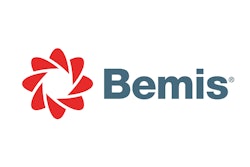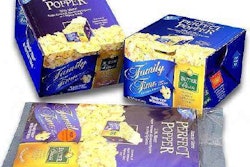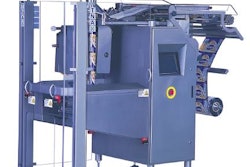A new addition for Heinz, the pouch has enabled the company to enter the "mid-tier" hotel market, as well as restaurants. While all products are filled into the same pouch size, fill weights vary between 1 and 1.5 oz, depending on the product. "This is a new foodservice pouch available nationally that began rolling out in October," says Matt Lindner, Heinz foodservice marketing manager.
Slightly more than 3 mils thick, the extrusion-lamination includes an outer polyester layer that’s reverse-printed flexographically in seven colors. Pechiney uses Flint Ink’s MultiflexTM solvent inks. The printed substrate, says Heinz, is coextruded to the aluminum foil, which is extrusion-laminated to a sealant film.
The use of transparent gold inks creates a shiny, gold frame to the copy on the front and back panels of the pouch that highlight the process-printed image of the product. These panels are accentuated by the pouch’s overall black background that provides contrast. Heinz’s Lindner credits The Design Center with creating the graphics design.
"Our idea was to present this as a pure food in the H.J. Heinz tradition," says Lindner. "Heinz had preserves before the 1900’s. We looked at some of the graphics from back then to help inspire this upscale look, and we used some of the quotes from Henry J. Heinz on the back of the pouches." Two examples: "Quality is to a product what character is to a man," and "To do a common thing uncommonly well brings success."
Lindner says William Rasile, manager of flexible packaging for the company’s foodservice division, was instrumental in bringing the pouch to market. Rasile says "we built a package that would provide us ample shelf life." Shelf life is about nine months.
Compared to other condiment packages, these pouches provide consumers with more product, and a large tear notch in the seal area that makes it easy to find, and open. "Younger people, and seniors, have had problems opening traditional condiment packages in the past," says Lindner. "That’s the great thing with these. Plus, the consumer can get close to 100 percent of the product out of these pouches."
Pechiney sends rollstock to Portion Pac/PPI for filling and sealing. PPI is a wholly owned subsidiary of Heinz U.S.A. "It’s filled on horizontal form/fill/seal machinery," says Rasile. Heinz preferred not to identify the equipment.
Portion Pac ships the pouches in 100-count case quantities. "We sell to restaurants, hotels, and resorts," says Lindner. "A lot of users, we’re
finding, are using them poolside because they don’t have to worry about glass breakage. While these won’t replace the small glass jars we have at some upscale hotels for room service, these pouches offer an option. For a hotel, they’re less expensive, and they create less waste. They’ve really taken off with our customers."























